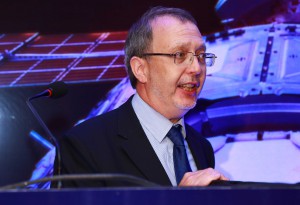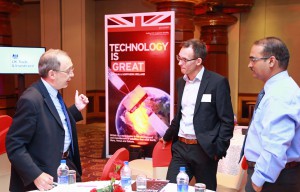24th September 2015 Bangalore, India
Manufacturing of the future
When we think of printing most of us think about a printer and paper. However in the last couple of weeks I learnt more about a different kind of printing called 3D Printing or Additive Manufacturing, that produces complex 3D geometric parts which cannot be made by traditional manufacturing. In 3D printing successive layers of material is deposited under computer control using high powered lasers. An excellent example is the Bloodhound Super-Sonic Car, which was unveiled this week. A number of components were made using 3D printing technology. For example Renishaw, a UK company with a base in Pune, is producing the steering wheel designed around the hands of driver, Andy Green, to get the best fit possible.
 There is a lot interest in India on 3D printing and how it can support its ‘Make in India’ campaign. So I was lucky enough to organize meetings and lectures for Prof. David Wimpenny, who is one of the world’s leading expert in the field of Additive Manufacturing. His ground breaking work at Warwick and DeMontfort Universities paved the way for the use of AM in the production of end use parts. He is currently the Chief Technologist at the National Centre for Net Shape and Additive Manufacturing, Manufacturing Technology Centre, in Coventry. The MTC is one of the High Value Manufacturing Catapult centres set up by several UK universities, global OEMs and investments by the UK Government to develop new manufacturing technologies and bridges the gap between early stage innovation and full-fledged large industrial manufacturing. The MTC is involved in developing a wide range of advanced manufacturing solutions from toolings and fixtures, metrology and non-destructive testing, assembly systems and data systems to component manufacturing including net shape and additive technologies. The UK’s innovation ecosystem was recently recognised as one of the best following the publication of the Global Innovation Index ranking.
There is a lot interest in India on 3D printing and how it can support its ‘Make in India’ campaign. So I was lucky enough to organize meetings and lectures for Prof. David Wimpenny, who is one of the world’s leading expert in the field of Additive Manufacturing. His ground breaking work at Warwick and DeMontfort Universities paved the way for the use of AM in the production of end use parts. He is currently the Chief Technologist at the National Centre for Net Shape and Additive Manufacturing, Manufacturing Technology Centre, in Coventry. The MTC is one of the High Value Manufacturing Catapult centres set up by several UK universities, global OEMs and investments by the UK Government to develop new manufacturing technologies and bridges the gap between early stage innovation and full-fledged large industrial manufacturing. The MTC is involved in developing a wide range of advanced manufacturing solutions from toolings and fixtures, metrology and non-destructive testing, assembly systems and data systems to component manufacturing including net shape and additive technologies. The UK’s innovation ecosystem was recently recognised as one of the best following the publication of the Global Innovation Index ranking.
Prof. Wimpenny spent about a week in India and his first stop was in Bangalore where he was a key technical speaker at the fifth international conference on additive manufacturing. The conference had global experts and was well attended by technologists from leading Indian and overseas institutions and companies. Also at the exhibition were two UK companies – Renishaw which makes 3D printers and LPW Technology which develops and optimises metal powder for additive manufacturing. Both the companies have a strong interest in the Indian market. 
Prof. Wimpenny also addressed aerospace companies in Bangalore at a separate event organized by my colleagues from UK Trade and Investment (UKTI). He spoke about how 3D printing technologies can impact global aerospace supply chains in the future. Aerospace parts can be printed on demand anywhere using 3D printers and he advised the companies to become familiar with this technology as it is set to transform the design of and manufacture of key aerospace components, enabling the next generation of aircraft to be more fuel efficient and cleaner.
Our next stop was in Mumbai where I accompanied him along with Prof Karunakaran, IIT- Bombay to visit Godrej Aerospace, which makes complex parts for the Indian space programme especially engines of the launch vehicles. Prof. Wimpenny shared the stage with Lord Francis Maude, Minister of State for Trade and Investment, where he addressed a packed auditorium in IIT- Mumbai on the role of Catapult Centres in the UK how they help to ensure that new technology can be exploited effectively by industry.
The next day we visited Renishaw’s new AM facility in Pune where the company has set up a solutions centre which offers companies to try out 3D printing and understand the kind of things that can be manufactured using 3 D printing. Later Prof. Wimpenny addressed about 30 automotive companies on the various technologies around additive manufacturing and applications in the automotive industry. Finally, we visited the impressive R&D centre of Bharat Forge called Kalyani Centre for Technology & Innovation in the outskirts of Pune. We were amazed at the level of expertise and quality of research undertaken by the company.
Finally, when I thought I had come to grips with terms such as subtractive manufacturing and additive manufacturing and their advantages and disadvantages, Prof. David Wimpenny pointed out that the future involved hybrid manufacturing technologies. Where the majority of metal parts is made by additive manufacturing require post-processing operations to improve their surface finish. Combining CNC and additive manufacturing allows component fabrication and surface finishing to be achieved in a single setup. This is a cost effective solution which can provide the both the capabilities in a single machine and thereby reducing cost and time. One of David’s students Dr.Jason Jones has set up an award winning company called Hybrid Manufacturing Technologies which sells the tool kit to enable hybrid AM to be undertaken on a conventional machine tool. This process has been tried out successfully on Germany and Japanese machine tools and Prof. Wimpenny hopes that one day hybrid AM could be offered on Indian machines as well! Any takers?